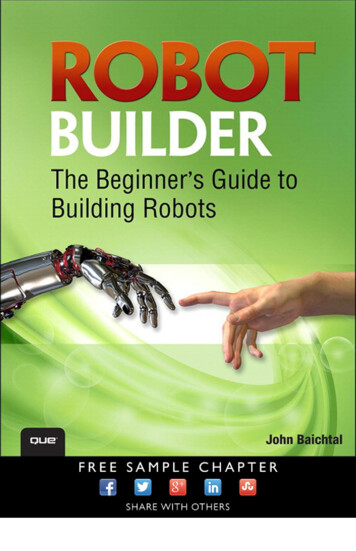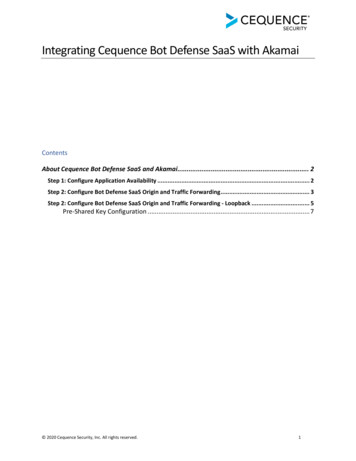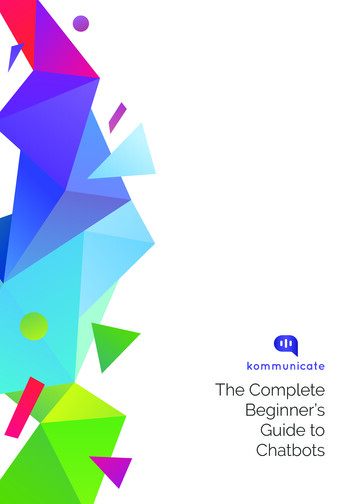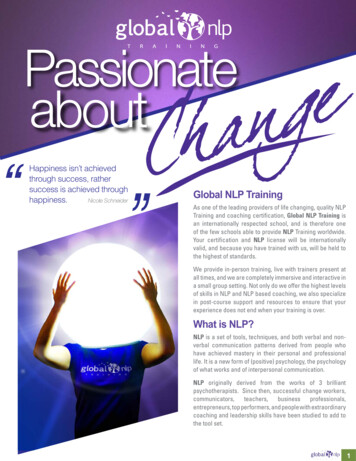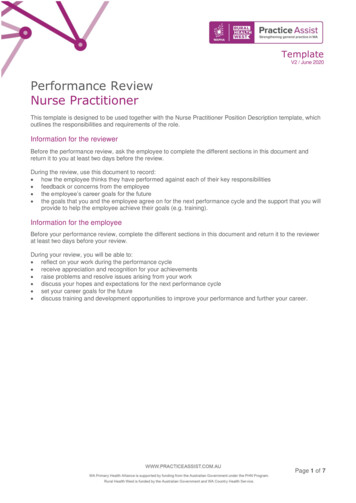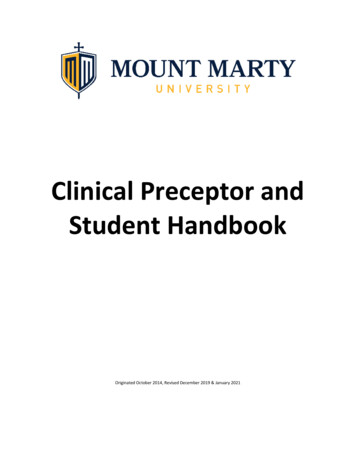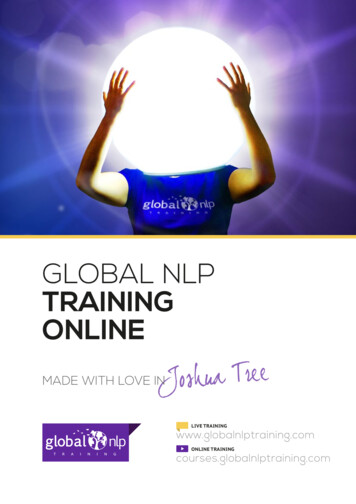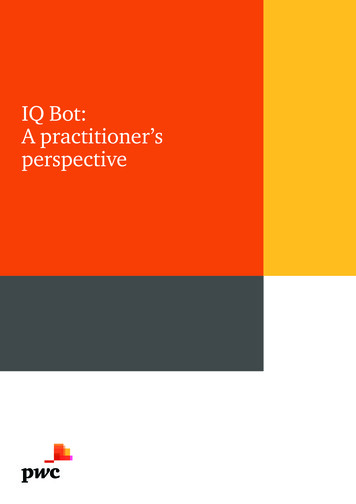
Transcription
IQ Bot:A practitioner’sperspective
Slowly and steadily, automation has started becoming ubiquitous. While an automated task bot can manage mostrepetitive tasks involving structured data, it is unable to handle a vast amount of semi-structured or unstructured data(or ‘dark data’).Dark data, which constitutes 80% of any business process, is posing a huge challenge to organisations. Processingdark data requires humans to locate the hidden data and create a structured format which can then be processed bytask bots.What is dark t esAudio/videoThis issue attracted the attention of various product companies working on automation and thus began a quest todevelop a technology that could understand dark data and enable its smooth conversion into a compatible formatfor bots.Today, multiple robotic process automation (RPA ) or intelligent process automation (IPA) solutions are available.Intelligent optical character recognition (OCR) is one such solution that is fast catching on in the IPA space, helpingorganisations to create a straight-through automation solution for processes with a high percentage of dark data.1.Rai, M. (9 November 2017). Can cognitive RPA help you emerge from the age of dark data? Automation Anywhere. Retrieved help-you-emerge-from-theage-of-dark-data2 PwC IQ Bot: A practitioner’s perspective
Breaking down intelligent OCRIn our previous thought paper, ‘Robotic process automation and intelligent character recognition’,2 we discussedIntelligent OCR and its application in simplifying paper-driven processes where inputs are received as PDF files,scanned, faxed and handwritten documents. The accuracy of intelligent OCR in the conversion of input documentshaving different layouts with varied resolutions and quality is unparalleled.However, the current RPA technology cannot address all the challenges in OCR automation. This is where IQ Botcomes in. With techniques such as continuous validation and AI, it enables an organisation to automate human-centricprocesses involving fields and patterns. IQ Bot is more accurate due to the learning from humans through the feedbackloop; it is also faster and virtually foolproof. At the same time, it reduces human processing costs.IQ Bot 5.3.1 aims to deliver automation using the cognitive technology that reads and processes dark datawhile improving its skills and performance by learning from people at work.Understanding IQ BotIQ Bot enables business users to create software robots with limited help from programmers. These robots can readand extract information from documents using AI and machine learning technologies. While RPA is rule based andalways requires human intervention for processing dark data, the combination of cognitive abilities with RPA enablesend-to-end process automation.Moreover, IQ Bot complements all RPA-based solutions to achieve end-to-end straight-through processing (STP3) forprocesses involving dark data. OCR is just one of the components of IQ Bot. It augments this technology by identifyingvariations in layout and content and helps in improving the extraction of fields by mapping them to the right variables.IQ Bot performs better than intelligent OCR as it can locate data, extract it, as well as learn which types of datato extract based on human corrections. To enable IQ Bot to perform these functions, proprietary IP algorithms aredesigned which run on a standard open source OCR.IQ Bot vs intelligent OCR4IQ Bot 75%1 STPEfficiencyIntelligent OCR 30% STPBasic OCR0% STP Classify Digitise Learn(laborious)(outdated)(limited) RecogniseUnderstandEnrichImprove(computer vision)(NLP)(fuzzy logic)(machine learning)Based on collated, averaged data from customer implementations12.3.4.PwC. (July 2018). RPA and intelligent optical character recognition. Retrieved from on-ocr-whitepaper.pdfSTP is the percentage of processes that can be fully automated without human intervention.Source: Automation Anywhere IQ Bot Product Team3 PwC IQ Bot: A practitioner’s perspective
So, how does IQ Bot increase the STP ability through RPA automation?Based on our experience with a couple of large RPA implementations, we have picked invoice-basedprocesses that are typically document heavy and entail multiple formats. We took a sample of 100invoices in 30 different formats, including scanned images and PDF files with unstructured data. Oneteam tried to automate the process using PDF integration and OCR, while the other team used with IQBot to extract the data for processing in SAP.1) RPA without IQ BotIn this case, documents were classified manually and then OCR was applied to extract data. Even afterthis manual classification, only 40% accuracy and 45% STP were achieved. The extracted data thenhad to be verified and approved manually by senior knowledge workers. Moreover, this process wastime-consuming and there were limitations with respect to certain invoice formats and data spanningmultiple pages.Business process without using IQ Bot5Classificationof provalFinal reviewand approval2) RPA cognitive IQ BotIn this scenario, IQ Bot learned from humans through a feedback loop. Thus, the efficiency andprocessing time of the process was improved, resulting in 75% accuracy and 80% STP.Business process using IQ on/processing faileddocumentsSource: IQ Bot 5.3.1 User Guide and release notesIbid.4 PwC IQ Bot: A practitioner’s view
Understanding the inner functioning of IQ Bot:1.Learning instance creation: In the first step, the information that has to be extracted from the documents needsto be specified. Key information can be specified to help the extraction process—for example, document type,language and fields. The required documents are uploaded to get an in-depth analysis report.2.Document analysis: In this step, the bot identifies:a.Similar documents and groups themb.Groups that are more likely to return all the required fieldsc.Groups that should be trained to ensure maximum veracity3.Bot training: At this stage, the user is able to review and adjust the automatic field name and value mappingsthat the cognitive system suggests. One document is selected per group and the bot is trained by mapping therequired field and setting up validation rules. The selected document must capture the traits of the maximumnumber of documents in the group. Moreover, this bot, when sent to production, will process all the documentsidentified as part of this group.4.Validation: At this stage, all the unprocessed documents become available for human validation. Users need to gothrough the validation errors and correct them. The IQ Bot simultaneously learns by observing human behaviourand is trained continuously.5.Progress monitoring: The IQ Bot dashboard helps in monitoring the progress of the learning instances inproduction.Functioning of IQ e: Integration of IQ Bot into the rest of the workflow(task bot and meta bot) is possible. Further, custom validationcan be performed on the data extracted by IQ bot.7.Source: IQ Bot 5.3.1 user guide and release notes5 PwC IQ Bot: A practitioner’s perspectiveProcessmonitoringValidation
The enhancements made to recent versions of IQ Bot are shown below:IQ Bot – version enhancements8Version 5.0.0 Flags exceptions based on confidence levelCaptures human expertiseSemantic analysisSupports documents like invoices, purchase order and billsAuto-filtering by data typeUndertakes work shadowing of the business resourceArithmetic, logical and date functionsField collision resolutionCross-field mappingMulti-language support, including English, Spanish, French, German and ItalianVersion 5.1 Accuracy and STP increasePerformance improvement – 5% increase in accuracy and STP raised by up to 10%UI changes – improved notifications, buttons, simplified yet elegant login screenPagination – improved interaction with classified groupUnused learning instances can now be deletedAccess to unclassified and unprocessed filesVersion 5.2 STP improvements Import/export tool – learning instance can now be imported/exported between versions,thus eliminating the need to replicate training across machines Character-level confidence threshold Supervised learning in validation Improved table extraction Password encryption Support for IE and Edge browser Automatic reclassification of unclassified PDF Automatic field mapping during bot creation – bots are now pre-trained using intelligence for determineddomains. Field labels, values and header are automatically mapped based on the results of theclassification process. Users are now only required to confirm/modify the fields that are mapped incorrectly.Version 5.3 8.Multi-language support – more than 25 languages are supportedAdditional table/section extraction – allows extraction of repeated tables and sectionsBOT store domain – document processing domain can now be downloaded from Bot Store and imported to IQ BotAdditional field for extraction – additional fields/tabular columns can now be added while editing a learning instanceAdvanced migration utilityTrained larger sized files – increased from 5 MB to 12 MBTask Bot compatible UTF-7 CSV outputCompliant loggingSource: IQ Bot 5.3.1 user guide and release notes6 PwC IQ Bot: A practitioner’s perspective
Let’s look at a recent client engagement where IQ Bot was used:ClientOne of the world’s largest steel manufacturing companiesBusiness driverThe inputs for the processes that had to be automated consisted of documents containing various formats,including invoices and purchase orders. The process of sundry payments alone involved invoices in 400 formats(.pdf, .tiff and scanned images). This made the conversion process extremely complex, and as a result, thecompany struggled to meet its yearly service-level agreements (SLAs) and targets, leading to staggered profits. Inorder to solve this problem, a solution that integrated OCR and PDF was initially recommended, but with variety offormats increasing every quarter, this proposition could not be sustained.SolutionAs a solution to the constantly changing and increasing number of formats, IQ Bot 5.3.1 was suggested as partof the process. After this enhancement, there was a 70% increase in accuracy and the quality of data extractedimproved by 65%. The previous process, which needed a lot of manual intervention, could now be automatedend-to-end. Thus, IQ Bot increased efficiency, accuracy, data quality and saved a lot of time, thus enabling theorganisation to meet their targets and SLAs.Moreover, following successfully deployment of IQ Bot, other processes have been taken up for automation.7 PwC IQ Bot: A practitioner’s perspective
Key takeawaysIn our journey towards realising the maximum potential of process automation, by using IQ Bot, we couldautomate most of the processes end to end with improved data quality and minimum time and effort. Thebenefits of IQ Bot are summarised below:1.A dashboard that provides a bird’s-eye view of the progress across all processes2.Recognition and categorisation of different document types and formats3.The ability to learn with every validation and facilitate continuous improvement4.Prevention of changes in existing workflows5.Sharing of domain configuration by bots to save time during the design process6.Usage of computer vision and machine learning to detect patterns and classify documents into groups inorder to reduce training redundancies7.Presence of an indicator that signals the accuracy and reliability of the botA few opportunity areas that can be explored in the upcoming versions for better user and developerexperience:1.IQ Bot 5.3.1 (being the latest at that time) did not work with Enterprise RPA 11.x. While we could still getthe job done with a lower version, compatibility with the new version would further enhance the userexperience.2.There are very few predefined templates and we are afraid that a lot of standard process templates in theindustry might have been missed out. We would be happy to see those implemented in the upcomingversions of IQ Bot.3.The current version didn’t support the splitting of documents automatically and the same had to be splitmanually in order to be processed. Although this could be done using task bot workarounds which are littlecomplex, we await a few enhancements in this area as well.4.During the creation of learning instances, the required fields need to be defined as a first step, and cannotbe edited or deleted later. A new feature can be introduced in future versions to edit the fields in order toimprove the developer experience.5.The dashboard displays cumulative information about the number of files processed, percentage of STPand accuracy, etc. However, another component that provides the actual number of files processed in aparticular run will make the user experience more comprehensive and effortless.6.On successfully completing the processing of scenarios where the task bot calls IQ Bot and waits beforerunning the next set of tasks, a notification or specific handle confirming this would be helpful.8 PwC IQ Bot: A practitioner’s perspective
IQ Bot marks a leap forward in terms of innovation. However, as is the case with most technologies, there arecertain limitations that need to be addressed.We end by outlining some of the features of IQ Bot 6.59 released recently:1)Compatible with 11.x version2)Toggle between OCR engines: Users can toggle between Tesseract4 or ABBYY FineReader Engine v12.2as IQ Bot’s OCR engine while leveraging IQ Bot’s native document classification, auto correction andextraction capabilities.3)Extended international language support: 190 languages, including but not limited to Asian languagessuch as Japanese, Korean, Chinese (Simplified) and Chinese (Traditional)4)Internationalisation and localisation: Users can select the language from a drop-down list at the time ofinstance creation.5)Database encryption: IQ Bot document data stored in database tables and columns is encrypted toprotect potentially sensitive information. As yet, this does not apply to field value data humans manuallycorrect in the IQ Bot validation queue.6)Audit logs for IQ Bot: The administrator can see action logs for all IQ Bot users in the audit logs tab of theEnterprise Control Room. Successful and unsuccessful actions are logged along with reasons for failurelogs.7)Windows authentication: The IQ Bot platform administrator can enable Windows authentication during IQBot platform installation, to connect SQL databases with Windows or dual authentication.8)Custom role-based access to IQ Bot instances through Enterprise Control Room.9)Microsoft Azure SQL database service Platform as a Service (PAAS):The IQ Bot platform administrator can enable Microsoft Azure SQL Database service during IQ Botplatform installation.As we gear up for an era where automation will no longer be confined to developers and intelligent bots willcontinue to be upgraded with more features, solutions like IQ Bot can play a major role in transforming theface of intelligent technology and making it faster, more reliable and user friendly.Our previous reportsAs the cognitive automation technology continuum is changing rapidly and technology innovation anddisruption become imperatives, we aim to bring you the latest developments through research a series ofwhite papers on IPA:Issue 1 – RPA in a virtual environment (May 2018)Issue 2 – RPA and intelligent optical character recognition (July 2018)Issue 3 – IQ Bot: A practitioner’s perspective9.Source: IQ Bot 6.5 user guide and release notes9 PwC IQ Bot: A practitioner’s perspective
About PwC’s Intelligent Automation (IA) practicePwC India’s IA practice assists clients in their intelligent process automation journeyfrom strategy through execution. With their extensive experience, our professionalssupport a transformation approach to automation, including continuous improvementand innovation to create a cutting-edge ‘IPA value proposition’. Our practice has diverseservice offerings covering strategy, governance set-up, automation feasibility and toolselection, centre of excellence set-up, implementation and deployment, bot-managedservices, functional and technical training, and risk assessment.The practice has a wide range of domain professionals and technical consultants withwide experience with global clients and in multiple industries/domain. The team hasdelivered 100 projects across industries and has automated 1,000 processes, creating1,500 FTE capacity. It has also deployed 2,000 active bots in production. Further,our team has strategic partnerships with top-tier market-leading RPA vendors and hasconsiderable experience in integrating RPA bots with niche FinTech solutions, OCRimplementation and conversational bots.10 PwC IQ Bot: A practitioner’s perspective
About PwCAt PwC, our purpose is to build trust in society and solve important problems. We’re a network offirms in 158 countries with over 250,000 people who are committed to delivering quality in assurance,advisory and tax services. Find out more and tell us what matters to you by visiting us at www.pwc.com.In India, PwC has offices in these cities: Ahmedabad, Bengaluru, Bhopal, Chennai, Delhi NCR,Hyderabad, Kolkata, Mumbai, Pune and Raipur. For more information about PwC India’s serviceofferings, visit www.pwc.inPwC refers to the PwC network and/or one or more of its member firms, each of which is a separatelegal entity. Please see www.pwc.com/structure for further details. 2019 PwC. All rights reservedContact usSumit SrivastavPartner and Intelligent Automation LeaderPwC Indiasumit.srivastav@pwc.comContributorsMadhushree KhapliAnkita RathoreNaman DeepSagar Kothe11 PwC IQ Bot: A practitioner’s perspective
pwc.inData Classification: DC0This document does not constitute professional advice. The information in this document has been obtained or derived fromsources believed by PricewaterhouseCoopers Private Limited (PwCPL) to be reliable but PwCPL does not represent that thisinformation is accurate or complete. Any opinions or estimates contained in this document represent the judgment of PwCPL at thistime and are subject to change without notice. Readers of this publication are advised to seek their own professional advice beforetaking any course of action or decision, for which they are entirely responsible, based on the contents of this publication. PwCPLneither accepts or assumes any responsibility or liability to any reader of this publication in respect of the information containedwithin it or for any decisions readers may take or decide not to or fail to take. 2019 PricewaterhouseCoopers Private Limited. All rights reserved. In this document, “PwC” refers to PricewaterhouseCoopersPrivate Limited (a limited liability company in India having Corporate Identity Number or CIN : U74140WB1983PTC036093), which isa member firm of PricewaterhouseCoopers International Limited (PwCIL), each member firm of which is a separate legal entity.SUB/July2019-18357
3 PwC IQ Bot: A practitioner’s perspective Breaking down intelligent OCR In our previous thought paper, ‘Robotic process automation and intelligent character recognition’,2 we discussed Intelligent OCR and its application in simplifying paper-driven processes
